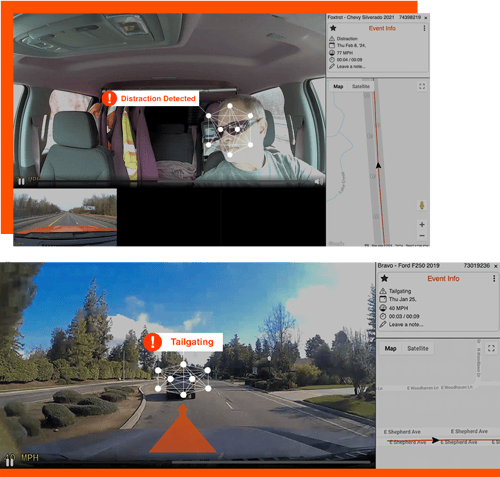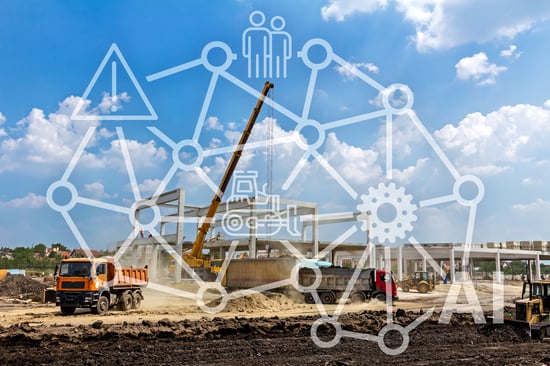
The construction industry is one of the most hazardous fields, with job sites presenting unique safety challenges. However, Artificial Intelligence (AI) is reshaping how construction companies manage safety. These advancements reduce risks, improve efficiency, and create safer work environments.
Traditional safety protocols often fail to address the dynamic and complex nature of construction sites. Manual monitoring lacks the real-time data, alerts, and predictive capabilities needed to prevent accidents.
predictive capabilities needed to prevent accidents.
AI fills these gaps, helping construction companies shift from reactive measures to proactive strategies. By using cutting-edge AI tools and techniques, construction firms can better monitor, predict and mitigate risks.
Types of AI in Construction
AI isn’t one-size-fits-all. Many popular tools, like ChatGPT, leverage generative AI, but the construction industry uses several different types of AI for many different use cases.
- Predictive AI: Analyzes historical data to forecast potential risks and prevent issues.
- Prescriptive AI: Offers actionable recommendations to improve safety outcomes.
- Generative AI: Creates innovative solutions like advanced training simulations or risk assessment models.
Each type serves distinct purposes and combining them can deliver comprehensive safety management solutions. Emerging AI applications give construction teams the tools to tackle safety challenges.
Construction Focused AI Gives Contractors a Competitive Advantage
It’s important to note that despite the type of AI, industry focused solutions come out on top. The same has been true for most emerging technologies throughout the digital age. Industry-focused tech is built to address the unique challenges of the sector it serves.
When technology products start to try to serve all or many industries, these solutions lose their efficiency and do not fully fit customers’ requirements. Additionally, generic technologies often do not integrate or complement the systems and processes each particular customer base uses. This only further creates data silos and broken workflows.
As mentioned above, AI is not one size fits all. Contractors who invest in solutions that are built for construction use cases will see the biggest rewards in their investments.
Predictive Analytics for Risk Mitigation
Predictive analytics is one of AI’s most impactful applications in construction safety. This technology examines historical data—including incident reports, injury logs and environmental factors—to identify patterns and predict hazards. With these insights, construction managers can address risks before they escalate.
 For example, AI systems can:
For example, AI systems can:
- Analyze equipment maintenance records to predict malfunctions that could lead to accidents.
- Monitor worker behavior to spot unsafe practices.
- Identify correlations between specific weather conditions and increased safety risks.
Contractors can use this information to make changes, adjust work schedules and improve safety rules.
Additionally, they can provide more personal protective equipment (PPE) in dangerous areas. This proactive approach significantly reduces incidents and safeguards workers and resources.
Expanding Predictive Capabilities in Construction
Predictive analytics can also factor in evolving conditions on the job site. By incorporating data from IoT sensors, AI systems can offer minute-by-minute updates.
For example, sensors on scaffolding can warn teams if they exceed weight limits. Weather monitoring systems can give early alerts for dangerous conditions like high winds or heavy rain. Engine-powered asset trackers can also provide usage alerts to trigger maintenance needs. These predictive capabilities ensure that teams stay ahead of potential hazards and project delays.
Real-Time Hazard Detection On and Off Jobsites
AI and Internet of Things (IoT) devices work together to detect hazards in real time. This technology allows for faster responses to potential dangers.
AI-Powered Dash Cameras
Construction dash cameras equipped with AI are essential tools for improving safety on and off job sites. These cameras go beyond basic video surveillance by using machine learning algorithms to analyze footage in real time. They can:
-
- Detect risky driving behaviors such as distracted driving, speeding or sudden braking.
- Monitor compliance with seat belt use, phone use and other safety protocols.
- Reduce blind spots around heavy equipment, preventing accidents caused by limited visibility.
Tenna's first-to-market heavy equipment camera provides operators visibility to improve safe operation. The in-cab monitor provides operators with 360-degree visibility around machines.
AI-powered dash cameras can also give in-cab, real-time feedback to drivers and operators and record near-miss events. This helps with driver and operating training and improving safety adherence.
Drivers and operators not at fault in incidents can use video evidence to exonerate themselves. Learn more about the benefits of dash cameras.
Drones for Jobsite Monitoring
AI-enabled drones are another powerful tool for real-time hazard detection. For example, DroneDeploy's Safety AI product automatically analyzes thousands of images captured every week on construction projects. The product then detects all visible OSHA safety risks to alert construction businesses.
 AI-powered drones can:
AI-powered drones can:
-
- Survey construction sites to identify structural issues or unauthorized access.
- Ensure compliance with safety regulations by monitoring worker activities.
- Capture aerial views of job sites, providing perspectives that ground-level inspections might miss.
Together, these technologies create safer and more transparent work environments, empowering teams to act swiftly to mitigate risks. Additionally, integrating drones with advanced analytics platforms allows construction managers to generate detailed safety reports, highlighting areas that require immediate attention.
Wearable Technology for Construction Workers
Another emerging trend in AI in construction is wearable devices like smart helmets and vests, such as the German Bionic Smart SafetyVest. These products have AI sensors that help improve real-time hazard detection. These devices can:
-
- Monitor workers' vital signs to detect signs of fatigue or heat stress.
- Provide geofencing alerts if a worker enters a restricted or hazardous area.
- Trigger immediate warnings when you detect unsafe conditions, such as elevated noise levels or air quality issues.
Wearables contribute to a more proactive approach to safety, ensuring that individual workers receive immediate attention when risks arise.
Automated Construction Safety Compliance
Maintaining compliance with safety regulations is critical but often challenging. Traditional methods rely on labor-intensive manual checks, which can be time-consuming and prone to error. AI can now simplify this process by automating key tasks.
AI systems built for construction compliance can:
- Track worker certifications and ensure training schedules are up to date.
- Generate real-time safety performance reports to highlight areas needing improvement.
- Verify construction plans for compliance with regulations using platforms like Document Crunch.
AI lowers administrative work involved in compliance and helps construction businesses ensure safety standards are followed.
More Efficient Compliance Documentation Processes
AI also improves the documentation process by digitizing and organizing records. Construction managers can use AI tools to quickly access permits, inspection records, and compliance reports. This saves time compared to searching through stacks of paper. These tools:
-
- Automatically flag missing or outdated documentation.
- Create templates for incident reporting that capture all relevant information.
- Integrate with cloud-based systems for easy sharing and storage.
This streamlined approach to documentation not only enhances compliance but also saves valuable time and resources.
Enhanced Worker Training Programs
AI doesn’t stop at monitoring and compliance; it’s also reshaping worker training. Generative AI can create immersive simulations, allowing workers to practice responding to real-life scenarios in controlled environments. This improves preparedness and reduces errors on the job.
For example, virtual reality (VR) training programs powered by AI, such as Serious Labs, can simulate scenarios such as equipment malfunctions or emergency evacuations, as well as operator training. Workers gain hands-on experience without exposing themselves to actual risks.
Additionally, AI analytics can assess individual training performance, identifying areas for improvement and tailoring future sessions accordingly.
AI Adoption for Construction Safety Operations
If you are comparing AI adoption to other digital process improvements you’ve made over the years, you should know this revolution is different. For context, generative AI has seen a 39.5 percent adoption rate over two years, compared with the 20 percent adoption rate PCs saw after three years.
For large-scale projects, robust safety management is essential. AI equips contractors with tools to predict risks, prevent accidents and protect workers. However, a critical piece of technology adoption is prioritizing use cases that make sense for your business. What technology one company is leveraging may not be the best use case for your construction business.
AI in construction will continue to change how contractors handle safety on sites, and integrating this technology is no longer a trend—it’s a necessity for modern safety management. As AI evolves, its potential to reshape the construction industry’s approach to safety will only grow. Companies that adopt these advancements today will lead the way in creating safer, more productive job sites tomorrow.
Contact Tenna to learn more about how our technology leverages AI to dramatically improve safety management in construction.
About Russ Young
As Chief Business Development Officer for Tenna, Russ oversees the growth strategy for the organization by working with sales, partners and customers to ensure success. Russ brings two and a half decades of experience from Google, Amazon, Oracle and FMI in best practices for technology strategy, selection and adoption. He applies his knowledge from these organizations to build awareness and provide thought leadership to the construction industry. He emphasizes the importance of technology and picking the right tool for the job.


